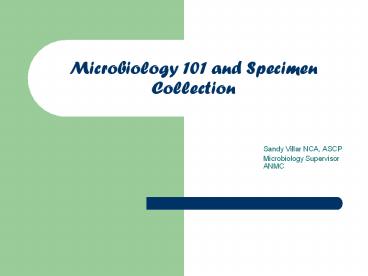Microbiology 101 and Specimen Collection - PowerPoint PPT Presentation
1 / 28
Title:
Microbiology 101 and Specimen Collection
Description:
Microbiology 101 and Specimen Collection Sandy Villar NCA, ASCP Microbiology Supervisor ANMC Transport of Specimens All specimens transferred between rural clinic and ... – PowerPoint PPT presentation
Number of Views:587
Avg rating:3.0/5.0
Title: Microbiology 101 and Specimen Collection
1
Microbiology 101 and Specimen Collection
- Sandy Villar NCA, ASCP
- Microbiology Supervisor ANMC
2
Transport of Specimens
- All specimens transferred between rural clinic
and ANMC are transported by Express Mail - Or other designated courier systems
- All specimens are transported in accordance to
the policy for Transportation of Dangerous Goods
and Material
3
Transport of Specimens
- Place all specimens in double biohazard zip-lock
bags - Tighten all specimen lids to avoid leakage
- Place biohazard bags into leak proof containers
with absorbent - Place vacutainer tubes or aliquot tubes into foam
insert to avoid breakage
4
Specimen and Container Types
- Abscess/aspirates
- Blood culture
- C. difficile
- Chlamydia trachomatis
- Syringe/Sterile screw cap containe, plain red
tube - BacT-Alert bottle
- Sterile screw cap container
- Female and Male Gen-probe collection container
5
Specimen and Container Types
- Fluids from sterile site
- Drainage, pus
- Group B Streptococcus
- Nasopharyngeal
- Sputum
- Stool culture
- Sterile screw cap container
- Swab in Stuarts transport media
- Swab in transport Stuarts media
- Sterile screw cap container
- Enteric Transport media
6
Specimen and Collection Types
- Stool Ova and Parasites
- Swabs for culture
- GC
- Swabs for culture
- wound,eye,vaginal,
- cervix,urethral
- throat
- PVA and formalin
- Swab in charcoal
- transport media
- Swab in Stuarts
- transport media
7
Specimen and Collection Types
- Urine Culture
- Clean, sterile container if transport lt2hrs
- Or grey-top preservative tube
8
Specimen Rejection Criteria
- Leaking Specimens
- Unlabelled/Mislabelled Specimens
- Incorrect collection container type
- Sputum-not expectorated
- Too old for culture
9
Rejection of Specimens
- Hemolysis results from poor techniques or
exposure to extreme heat or cold - Clotting results from insufficient inverting
- Improper tube collection
- Underfilling or Overfilling of specimen
container
10
Unacceptable Specimens
- Specimen contaminated with IV fluids
- No label
- Orders do not match specimen
- No orders with specimen
11
Specimen Handling Requirements
- Fasting
- Timed
- Random
- Iced/or at Cool Temperatures
- Peak
- Trough
- Protect from Light
12
Labeling Procedures/Proper Identification
- All specimens require a proper label
- patients surname, first and middle, including Sr
or Jr - patients hospital identification
- or birth date
- Note both of the above MUST match the
requisition form - date/time of collection
- phlebotomist initials
13
Proper labeling
- Place patient label over preexisting blank label
on evacuated tubes - Place patient label along the length of a
microtainer tube, not obscuring the volume
measurements
14
Tranporting Specimens
- Double bagging
- Recheck identification
- Sample Requisitionproper handling
- Communicate to lab
15
Phlebotomy TechniquesGeneral steps
- Call lab for clarification of orders
- Organize equipment
- Patient assessment
- Greet patient
- Proper identification
- Position patient
- Use Universal Precautions
- Assemble equipment proper equipment, order of
draw - Select the best site
- Be aware of complications
- Proper preparation of site
- Perform the venipuncture/release tourniquet
- Control bleeding
- Invert anticoagulated tubes
- Properly label specimens at bedside/phlebotomy
chair - Care of puncture site
- Transport specimens to lab
- Maintain aseptic techniques
16
Four Secrets of Painless Venipuncture
- Medial Cubital Vein
- Size of Needle
- Allow the alcohol to Dry
- Skin is taut
17
Specimen CollectionMinimize the Trauma of
PhlebotomyStrive to give your best first time,
every time
- If your first puncture fails
- Avoid trauma by asking for help
- thou shalt not dig for a vein
- Withdraw needle if experiencing excruciating pain
- Withdraw needle if hematoma begins to form
- Withdraw needle if patient begins to faint
18
Vein location in arm
19
Vein location in Hand
20
Collection Complications
- Uncooperative patient
- Fainting
- Edema
- Mastectomy
- Hematoma
- Scarring/Burned area
- Rash/hives
21
Collection Complications
- IV drug user
- Obesity
- Reasons for short draw
- Reasons for no flow
22
Step 1
23
Step 2
24
Step 3
25
Step 4
26
Step 5
27
Step 6
28
- A problem is a chance for you to do your best
- Duke Ellington

